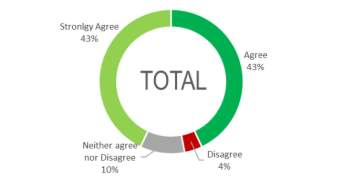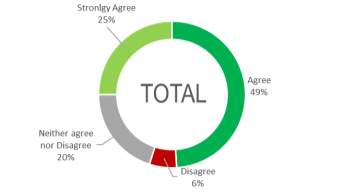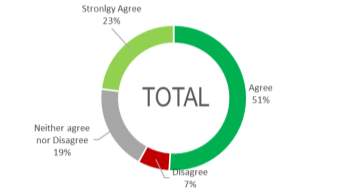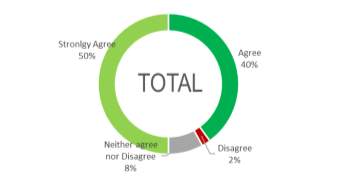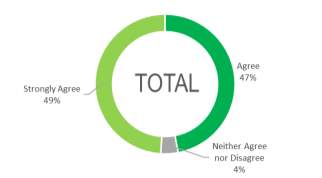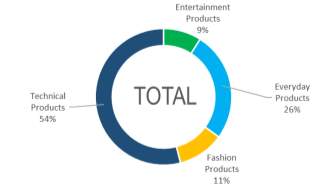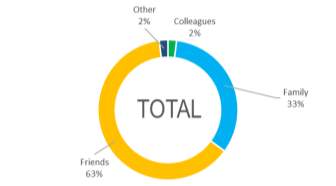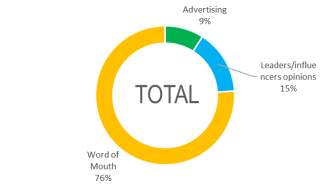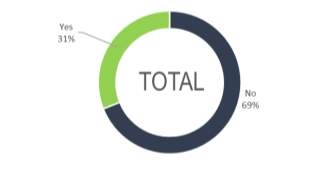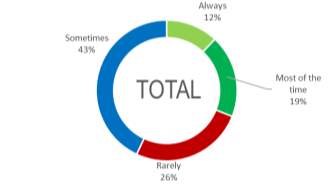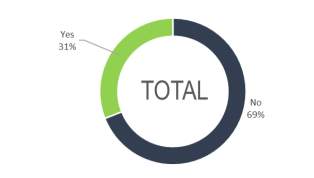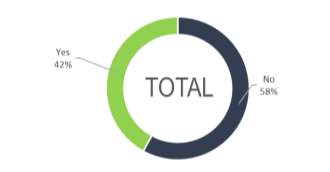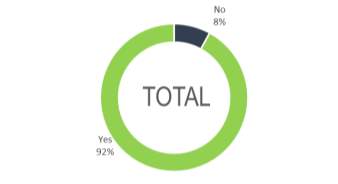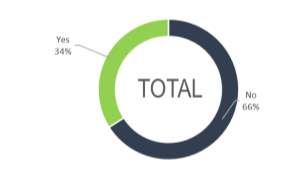Influence of Word of Mouth and Attitude of Consumers in Purchase Decisions
Info: 20736 words (83 pages) Dissertation
Published: 21st Oct 2021
ABSTRACT
The purpose of this research is to perform an analysis of the relationship between the influence of the WOM and the attitude of the consumers, in the buying decision process within a platform like WeChat. A detailed theoretical review and a valuable methodological contribution are presented through quantitative research using an ordinal and nominal scale of discrete variation, and evaluated through a survey designed to obtain perceptions that allow us to know the relation that Exists between the influence of the WOM and the attitude of the consumers and the purchase decision.
The results of the correlations between the variables allowed to evidence with a high level of significance that attitudes can determine a purchase decision. Motivations, barriers, trust, relationships and similarities are learned predispositions and draw particular attitudes that definitely affect a buying decision. Likewise, it was verified that WOM evidently plays an important role and is an influential factor in the purchase decision. In addition, the results allowed us to have a corresponding approach on the motivations and barriers of a consumer / person to talk or share information about a brand or product on WeChat.
KEY WORDS: Word of mouth, consumer, attitude, purchase decision, user generated content, WeChat.
TABLE OF CONTENTS
1.1 Background of the research study
2.1 WOM defining Characteristics
2.2 Traditional and electronic WOM communication
2.3.2 Tie strength between sender and receiver
2.4 Motives of WOM communication
2.5.2 WOM and stages of decision making process
3.3 Questionnaire design and measurement scales
6.1 Theoretical and managerial implications
6.2 Limitations and Future Research
LIST OF FIGURES
Figure 1: The conceptual framework approach to analyze the impact of WOM communication.
LIST OF TABLES
Table 1: WOM definitions based on supportive literature review
Table 2: Measurement items based on supportive literature review
Table 3: Influence of WOM vs. purchase decision correlation
Table 4: Consumer attitude vs. purchase decision correlation
LIST OF GRAPHICS
Graphic 1: “Preference of the source”
Graphic 2: “Preference of the source in age ranges”
Graphic 3: “Trust on friends’ recommendations about everyday products”
Graphic 4: “Trust on friends’ recommendations in age ranges”
Graphic 5: “Attitude towards negative WOM”
Graphic 6: “Attitude towards negative WOM in age ranges”
Graphic 7: “Expression of a negative experience”
Graphic 8: “Expression of a negative experience in age ranges”
Graphic 9: “Share of positive commentary”
Graphic 10: “Share of positive commentary in age ranges”
Graphic 11: “WOM trustfulness for the purchase of products”
Graphic 12: “WOM trustfulness for the purchase of products in age ranges”
Graphic 13: “Value of opinion”
Graphic 14: “Value of opinion in age ranges”
Graphic 15: “Determinants on purchase decision”
Graphic 16: “Determinants on purchase decision in age ranges”
Graphic 17: “The effect of negative commentary”
Graphic 18: “The effect of negative commentary in age ranges”
Graphic 19: “Attitude towards a bad experience”
Graphic 20: “Attitude towards a bad experience in age ranges”
Graphic 21: “Opinion trustfulness for daily use items”
Graphic 22: “Opinion trustfulness for daily use items in age ranges”
Graphic 23: “Opinion trustfulness for expensive items”
Graphic 24: “Opinion trustfulness for expensive items in age ranges”
Graphic 25: “Attitude concerning a shameful product/service”
Graphic 26: Attitude concerning a shameful product/service in age ranges
Graphic 27: “Negative impression perception”
Graphic 28: “Negative impression perception in age ranges”
Graphic 29: “Wellness in expressing negative experiences”
Graphic 30: “Wellness in expressing negative experiences in age ranges”
Graphic 31: “Trust on homophilous source”
Graphic 32: “Trust on homophilous source in age ranges”
Graphic 33: “Motivations to share experiences”
Graphic 34: “Motivations to share experiences in age ranges”
Graphic 35: “Sharing of comments with low degree of dissatisfaction”
Graphic 36: “Sharing of comments with low degree of dissatisfaction in age ranges”
I. Introduction
1.1 Background of the research study
In today’s constantly evolving interactive world, the popularization of the Internet and mobile phones especially with social networks, have potentiated the effect and influence of word of mouth, “The world’s most effective, yet least understood marketing strategy”.[1] Traditional WOM has always played an important role on consumer behavior, this disruptive and dynamic channel of communication can enrich and strengthen relationships between the brand and the consumer through the power of recommendation; people frequently share information and opinions with their social ties, either to demonstrate a certain kind of social status or simply because they had a good or bad experience with a product or service. In a consumer driven society, WOM deserves a serious attention, consumer mindset has changed, they have gone from being passive recipients of advertising messages that are used to follow the recommendations of manufacturers and retailers to be active participants in the market, they have become skeptical about traditional advertisement and marketing and prefer to make purchasing decisions based on real opinions and experiences. According to a study in 2007 by the WOMMA (Word of Mouth Marketing Association), about 90% of purchasing decisions are made under the influence of recommendations, while about 70% occur under the impact of traditional media.[2]
In addition of a significant growth in strength and credibility, WOM finds an added value with the emergence of the Internet and social networks, the possibility of being measured, an event that will certainly help to improve the results of approaching recidivists and recent customers, “Assessing the impact and volume of word of mouth can help companies and brands to understand the effect of this one in their marketing and their approach to and new consumers” (Bughin, Doogan, and Jørgen, 2010)[3], measures such as Insightpool, Word of Mouth Index and Net Promoter Score (NPS), has been adopted to collect WOM rankings on websites and social media networks, so that companies can have a better picture of the proportions of their audience and find consistent response that in effect will reach the right people with the right content.
This research aims to explore and analyze the attitude and behavior resulting from the exchange and shares of opinions between consumers through mobile social networks. In addition, have a corresponding approach on the motivations of a client /person to talk or share information about a brand or product on mobile social networks. The methods of this study are based on findings from an online survey summited to WeChat users, the results will deliver the answer of the research question based on the influence of Word of Mouth and the attitude of the consumers in WeChat in the purchase decision.
1.2 Research problem
What is the relationship between the influence of the WOM and the attitude of the consumers in WeChat in the purchase decision?
Objective: Identify if there is a relationship between the influence of the WOM and the attitude of the consumers in WeChat in the purchase decision.
1.3 Research questions
What are the motivations and barriers on consumers when sharing an opinion about a brand or product on WeChat?
Will consumers’ attitude towards Word of Mouth on WeChat be influenced by the strength of the tie with the sender?
Will the consumer’s attitude towards Word of Mouth on WeChat be influenced by a similarity with the sender?
Will the consumer’s attitude toward Word of Mouth on WeChat be influenced by their confidence with the sender?
1.4 Motivation of Study
In a consumer-driven society, the line between the roles in marketing becomes blurred, online consumers’ search for brand information, creation of content and willingness to share content with others is extremely useful in increasing brand engagement and relevance. Traditional Marketing seems to be outdated, since it relies on strategies where messages are transmitted without opportunity of immediate feedback or analysis.[4] There is a significant amount of research about the Internet as a medium of communication and marketing tool, it is likely that a similar approach could also be taken for other industries where information sources such as reviews and ratings websites exist. However, these studies are conducted in a time when consumer opinion platforms and online forums are the preferred destination for social interactions with fellow consumers, which means that in the constantly changing landscape and dynamic environment, with a proliferation of commercial product reviewing sites and the popularity of social networking sites, these findings seem outdated, this topic requires an updated approach and strategies that can be implemented to this new systems when it comes to consumer behavior on mobile social networks and this thesis explores it.
II. Literature Review
2.1 WOM defining Characteristics
The following definitions established in previous research are proposed in order to have a better understanding about WOM.
Table 1: WOM definitions based on supportive literature review
| Definition | Supportive Literature |
| “The act of exchanging marketing information among consumers.” | Katz, E. & Lazarsfeld, P. F. (1955).[5] |
| “Oral person-to-person communication between a receiver and a communicator whom the receiver perceives as non-commercial, regarding a brand, product or service.” | Arndt (1967).[6] |
| “Word of mouth as the opinion which consumers communicate to others in an unofficial way after they have used a product or taken a service.” | Westbrook (1987).[7] |
| “The world’s most effective, yet least understood marketing strategy.” | Misner, I. R. (1999).[8] |
| “EWOM communications are more measurable than traditional WOM.” | Lee, Park and Han (2008).[9] |
| “Informal information exchange about products or services between consumers. Word of mouth can be characterized as traditional when occurring in face-to-face communication, or electronic when exchanged.” | Barbara Gligorijevic (2013).[10] |
| “Consumer-to-consumer brand conversation or mention, online or off .” | WOMMA 2014.[11] |
2.2 Traditional and electronic WOM communication
WOM is described as “The world’s most effective, yet least understood marketing strategy”[12], is defined by others as the act of exchanging marketing information among consumers[13], People engage in functional conversations about a product, brand or service to obtain the information needed to make decisions and better interpret the world around them. Now, it is interesting to consider how nowadays technology can shape Word of Mouth; the advent of the Internet brought about a change in the way Humans communicate and relate, bringing with it a dynamic in communication where each user stops being a receiver of information and becomes a co-creator, this is how the personalization and Immediacy of the contents became the new Dynamics in the use of the Internet.[14] Over the course of time Word of Mouth has been transformed integrating to the media and information is now shared from chats, publications and others in a personal way, from one person to another. Now customer feedback on the Internet is available to a large number of other customers, so it can be expected to have a significant impact on the success of the goods and services.[15] Among a myriad of opportunities, technological changes have also facilitated the study of word of mouth itself, given that online articulations such as Tweets, online reviews, and blogs are somehow “big data” sources of real sharing behavior.[16] In the same way, it makes it possible for a company to follow and protocolize the client’s articulation in a detailed way that is not originally possible with the traditional word of mouth.[17]
EWOM is timeless, the speed of information on Word of Mouth Marketing reaches unprecedented proportions, when one comments something to a person, both become agents diffusing the initial information and so on in geometric progression. Speed implies that we have an important competitive advantage over our rivals, we will arrive before him to the final consumer. A study made from The Word of Mouth Marketing Association (WOMMA) affirms WOM has a more immediate impact than traditional advertising, about 90% of online WOM’s impact is in the first two weeks.[18]On the other hand, the Internet allows the comment of a consumer to remain visible for an indefinite period of time, so it can be seen by multiple individuals. In fact, it has been stated that “WOM may be endogenous because it not only influences new customer acquisition but also is itself affected by the number of new customers”.[19] Unlike face-to-face communication, in an online environment the audience is not physically present and involves written communication to share with a large audience of weak ties rather than strong ties, these factors should lead to a greater impact on the creation of the message, since people can take the time to adjust any identity they prefer through what they share.[20] Likewise, the assessment of homophily in an off-line environment is based on determinants such as gender, age, social and professional status, and ethnicity, but in an online environment, these signals can be “filtered” That is to say, disappeared, reduced, camouflaged, or even intentionally falsified.[21] Hussain et. Al affirmed online reviews provide an open source of extensive information about a particular product or service to consumers. On the internet, “consumers feel that other consumers are more intelligent and expert shoppers rather than their personal reputation in the online community.”[22]
To provide a better understanding of consumer behavior on a completely further level through the consumption of online content, the role of issuer or receiver has been conceptualized in previous studies as active or passive participation; one in particular showed the impact of electronic WOM is very strong for info-active consumers, their attitudes and subsequent purchasing decisions. Whereas, info-passive consumers are influenced by traditional WOM and retailers.[23] Subsequently, a study conducted to analyze Chinese consumers’ attitude change and behavioral intention in terms of eWOM messages argued eWOM communication reflected prevalent collectivistic cultural values between Chinese, since they valued friends and groups integrity in their decision-making processes.[24]
2.3 Elements of WOM
2.3.1 Receivers expertise
In eWOM communication the most commonly investigated factors are those related to the psychological state of a recipient, such as purchase intention, attitude, information adoption and trust. [25] In the context of eWOM communication, the experience of the receiver is decisive, since a receiver who believes that an eWOM message is credible tends to learn from and use it. Conversely, a recipient who perceives an eWOM message as not credible is unlikely to risk acting on the review. [26] The influence of WOM on receiver’s purchase decision will be influenced by the receiver expertise given that “The greater the receiver’s expertise, the less is the influence of WOMC on receiver’s purchase decision”. [27]
Other aspects affect the perception of the receiver of WOM, positive and negative, the effects equally differ depending on the strength of the tie with the sender, and how the WOM source affects the influence of WOM on the behavioral attitude and the intention to buy[28], which we will analyze below.
2.3.2 Tie strength between sender and receiver
Several studies have found Tie strength is one of the most significant factors explaining the influence of WOM communications,[29] although the idea of individual-to-individual social ties is less relevant in an online environment than an offline one, when there is no explicit type of “interpersonal relationship” between an information seeker and another individual as the information source.[30] With readily available personal networks in SNSs, consumers’ product choices may be influenced by both stable and intimate ‘strong tie’ interactions and randomly or remotely connected ‘weak ties’.[31] Most of the studies conclude that the greater the strength of the tie between the sender and the receiver, the greater the influence of the sender’s WOMC on the receiver’s purchase decision. [32]
Although strong ties exert a more significant impact at the individual and small group level, in relation to the influence on the decision making, consumers now are placing a lot of weight on sources of information that would not be expected to be powerful influencers such as nonexistent or weak sources.[33] The asynchronous and connective characteristics of social networks allow weak ties to expand their potential influence by extending consumers’ personal networks to external communities or groups. This accelerates eWOM conversations throughout a large-scale network. [34] Strong ties are important for the transfer of valuable information, weak ties facilitate the bridging function and spread of information between networks, hence both were found significant to eWOM behavior via social media. [35] Strong ties, for example, or people one interacts with frequently, should be more chronically accessible than weak ties. There are possibilities for weak ties to play an important role in the high context where information flow is not direct and explicit. [36] While some studies confirm that WOM information coming from close social circles is the most reliable source of information in all age groups[37] others have a deeper approach revealing that the probability of choosing strong tie sources is influenced by task difficulty and prior knowledge; therefore, consumers who perceive great difficulty in the decision task are likely to look forward strong tie sources for recommendation. On the contrary, the probability of choosing sources of weak linkage is influenced by the importance of instrumental cues and subjective prior knowledge.[38]
Communicating to close versus distant others activates distinct psychological motives that drive consumers’ behavior in their social interactions and affects the kind of information they share, these tendencies are tied to consumers’ motives to self-enhance and protect others, communicating to a close versus a distant other increases the sharing of negative information. When aiming to self- enhance, positive information might become more valuable to the self than negative information. In contrast, when aiming to protect others, negative information might become more valuable to the self than positive information.[39]
2.3.3 Senders characteristics
Homophily/Similarity:
Homophily or Similarity have been identified and tested in previous research determinants of interpersonal influence and therefore in the effect of the WOMC references. Both should be directly related to the influence of the message on the receiver. [40] “Social networks may excel in attracting homophilous consumers, and this phenomenon increases the likelihood of those consumers’ engagement in eWOM behavior.” [41] In e-WOM, the process of social interaction occurs in a distinct way, since it is not necessarily required that people know each other beforehand or have any physical interaction. Here social contagion is usually made through individuals who are structurally equivalent, that is to say, people who share the same social status, interests, hobbies or profession. [42]
Recent studies raised online Homophily is almost entirely independent of the interpersonal factors with which it is traditionally associated such as an evaluation of individual age and socioeconomic class. Rather, these findings suggest factors such as notions of shared group interests and group mind-set evaluated at the level of the Web site itself drive online homophily. [43]
Source credibility:
WOM is almost unbeatable regarding influence and persuasion capacity, nor the best advertising can match a personal recommendation’s credibility. This is how large companies have erected authentic empires based on the reputation and recommendations of myriads of satisfied customer. The credibility of the source can be defined by two elements, source experience and source bias; source experience is the perception about the competition of the source that provides the information and source bias is the possible incentives that can be observed in the source information.[44] Credibility stands closer to the offline communication, but still retains some unique attributes due to the nature of the environment in which the eWOM social network is created and propagated; The credibility of the information is evaluated by the consumer in relation to the website it is obtain from, as well as the contributor of that information.[45] In terms of the probability of the receiver to try, the main difference between traditional WOM and e-WOM is that technology allows people to interact without the previous physical interaction. This feature accelerates the process of social contagion when perceived risk comes from normative influence.[46] User generated content, considered the electronic format of WOM, is an accepted source of information, although its perceived reliability is rather less due to the possibility that the content can be edited or manipulated.[47]
The trustworthiness of the recommendation source plays an important role in WOM. Traditional WOM emanates from a sender known by the receiver of the information, thereby, the receiver has knowledge of the credibility of the communicator and the message. On the contrary, the electronic nature of eWOM in most applications eliminates the possibility of the receiver to judge the credibility of the sender or his message.[48] As mentioned above, in traditional WOM, the receiver of the message knows perfectly well who is giving the suggestion, so the biggest problem to face could be knowing if the sender is the right person to ask for the particular advice. However, in e-WOM, sender and receiver usually do not know each other, so here the query is how the receiver could perceive whether a message has been published honestly.[49] Nevertheless, the procedure that requires a mutual agreement of consumers to become friends and join other people’s networks present in some social networks and application, allows consumers to pass through profiles, which can increase the credibility of their contacts and inspire high levels of social trust. Finding that the higher the level of trust that social networks users have in their contacts, the greater the likelihood they will get involved in the opinion-seeking, opinion giving and opinion passing behavior.[50] SNS users appeared to spend at least some effort on attempting to evaluate individuals who provided information to the website, as well as the website itself.[51] Recent findings affirm credibility moderates the relationship between eWOM behavior and brand attitude formation, explaining that high source and message credibility induced more favorable attitude towards the brand than when either one or both were low in the context of the study.[52]
Furthermore, argument strength and perceived expertise have been consistently shown to be the most common determinants on information credibility.[53] Additional studies supports these findings when argument quality was identified as the most determinant factor of persuasive eWOM messages followed by source credibility. [54] Developing a framework upon the Brunswikian lens model, a recent study concluded that identity claims (arguments strength and perceived expertise) and behavioral residues (graphics, external links, recommendation ratings, and wall postings) affect the user’s judgment of an eWOM message through consistency checking and knowledge-based validation.[55]
2.4 Motives of WOM communication
Jonah Berger suggested that word of mouth can be understood in terms of five key functions that it serves for the word of mouth transmitter: impression-management, emotion regulation, information acquisition, social bonding, and persuasion.[56] Further studies revealed that consumers’ desire for social interaction, desire for economic incentives, their concern for other consumers, and the potential to enhance their own self-worth are the primary factors that motivated them to participate in eWOM. From this approach providers can be grouped based on what motivates their behavior, what can be used by firms to develop different strategies for encouraging eWOM behavior among their users. [57] Nevertheless, it is considered most of what people share is self-oriented or selfish. Whether it is to present a certain image to the public, regulate their emotions, acquire the desired information, deepen social bonds, or persuade others. all these motives are relatively self-centered and are explicitly motivated by the self. [58] A study focuses its analysis on the generation Y behavior towards eWOM, discovering that people who belong to this category consider online discussions and blogging as a way of “show off”, perceiving blogs and social media as a medium that allows them to express personal opinions that may not be interesting for others.[59]
Formerly, Jonah Berger affirmed “Consumers share positive emotions to re-consume or extend the positive affect. When something good happens, we want to tell others.” [60] Likewise, an empirical study of about 2,900 German platform users illustrated that readers find information content particularly important because it allows them to make better buying decisions and complete their searches in less time.[61] In this context, organizations are increasingly interested in listening to consumer dialogues as content generators and valuing these conversations with the intention of carrying out strategies that allow them to establish loyalty ties and commitment to customers towards their brands. Following this approach, A recent study suggests that advice seeking and social benefit are two motivations significant to brand-related conversations on social media as they both help fulfil two core uses of social media: nurturing relationships and conversations. [62]
2.5 WOM on consumer behavior
2.5.1 Characteristics
The current advertising saturation to which consumers are exposed leads advertisers to rethink new advertising strategies through existing media in order to reach their target audience. The new consumer has changed, this is now an individual characterized by its high capacity to exploit the opportunities offered by technology and especially the internet. Due to these events, social media has introduced new channels for communication processes, which has altered the information search styles of some consumers, and therefore altered their buying behavior.[63] “Knowing what topics people talk about is interesting, but it says little about the drivers of discussion, or why people talk about some products and ideas more than others.” [64] The result of the interpersonal exchange is the provision or access of information related to consumption, which contains some “informative value” above the formal advertising messages provided by the company and that influence the decision making of the individual. [65]
Despite the novel advantages that the implementation of WOM strategies in organizations can provide, it should not be overlooked that this can also have a negative effect; positive and negative WOM influence the behavioral intention in roughly the same way for customers and noncustomers. [66] but negative WOM can includes behaviors such as product denigration, relating unpleasant experiences, rumor and private complaining[67], which can affect the consumers’ perception and consequently harm the brand image. There are studies that have focused on detecting diverse ranges of consumer categorization, for example, based on their information searching practices, between the extreme polarities of info-active and info-passive Internet users. Info-active consumers rely strongly on electronic WOM, and consider their online searches to be a productive, valuable and information rich practice. Info-passive consumers conduct superficial online searches and show a strong preference towards face-to-face communication and traditional WOM. [68] Not all consumers are the same, therefore they should not be treated the same way.
2.5.2 WOM and stages of decision making process
Decision- making processes are influenced by a number of factors that determine consumers’ choice of certain products or services, WOM is one of the most influential variables in this process, as many of the studies carried out in recent years on this subject indicate. Findings showed that characteristics of social tie influenced recipients’ behaviors, but had different effects at different stages; tie strength only facilitated awareness, perceptual affinity or homophily unleashed recipient interest and demographically different ties were more influential than demographically similar across different stages of the decision-making process.[69] Similarly, a following study finds that information usefulness had a strong and significant impact on consumer decision to adopt information within online communities.[70] During the later stages of the decision process, expertise of the source will only exert influence to the extent that it affects the perceived costs or benefits of the recommended product or service.[71] Motivations, barriers, trust, relationships and similarities are learned predispositions and draw particular attitudes that definitely affect a purchase decision.
2.6 Opinion leaders
Customers or entities that are opinion makers and have a high impact on the market, are known as influencers and evangelizers. Influencers can range from ordinary people with a high-profile Twitter profile to prominent mass media figures. The evangelizers, meanwhile, another fundamental entity for WOM, are fans who actively promote among their circle the use of a brand. Based on the review of existing WOM and opinion leadership literature, studies insure it is intuitive that opinion leaders in the mobile phone categories would be tech savvy, a concept used to explain how much a consumer can relate to the benefits when the seller communicates the superiority of a product in terms of technical specifications.[72]
An opinion leader exerts greater power because of his status as an expert and reliable source, this figure verbally exposes his arguments with a direct and not too formal rhetoric, strengthening the strongest ideas and trying to continually create identification links in his discourse. Under this context, a study shows that the WOM sought by experts has a greater influence on the behavioral attitude and intention of the receptor than the WOM sought through strong or weak ties.[73] Likewise, the same study evidence experts mainly promote positive WOM, which makes the communication easier.[74] The experts must communicate effectively their ideas and messages, seeking the trust and empathy of the other members of the group through shared references or a tone adapted to specific circumstances. Additionally, a recent study finds that non-opinion leaders are less likely to seek opinion. It also reveals that knowledge of technology is correlated with information consumption and information creation from both friends and social media.[75] Influence is based on authenticity but it does not arise by spontaneous generation, it is the access to information and the unit to enable others to communicate clearly and convincingly, without ever leaving aside the congruence of what you want to communicate. Influencers are not necessarily celebrities, and may not have the impressive appeal that celebrities have, but they have something even more valuable; Their audience trust when it comes to buying recommendations.[76]
2.7 Negative WOM
“Consumer perceptions are usually based either on prior personal experience or reports of the prior experiences of others”[77] The valence of WOM can vary from positive to negative, if we have a bad experience with a product or service, there are many reasons to tell others and this can strongly affect the brands that receive this bad image. In positive WOM, the consumer conveys information that gives a positive feeling in order to help others, an intention to appear knowledgeable or intelligent, ego defense and reduction of dissonance, while in the case of negative WOM, Consumers transmit information about an unfavorable experience with the product or service, poor performance, high prices or rude sales personnel.[78]
Formerly, it was found that extremely dissatisfied customers engage in greater word of mouth than high satisfaction customers, whence negative communications are likely to have a greater impact than positive information, although the difference between the two are probably not significant.[79] A more recent study reformulates this concept, stating that people do not display a simple preference for bad news. Instead, they pass along information that matches the emotional valence of the conversation topic. [80] The likelihood of negative WOM is often related to the degree of consumer satisfaction or dissatisfaction. When minor dissatisfaction is experienced, consumers’ responses are often minima, in most cases consumers do not complain or disseminate negative reviews about the product concerned. Compared to when the dissatisfaction is serious enough, consumers tend to complain, regardless of other factors in the situation.[81] If we observe the communication between strong ties, we can state that this group creates an extensive amount of WOM, unfortunately, they seem to promote more negative WOM than positive WOM.[82] From the company’s perspective, a bitter experience of any product or service as well as any comments, especially negative, can cause difficulties and consequently affect their brand image, since the negative WOM or any negative comments influences more strongly than the positive.[83] However, what seems intuitively logical is not necessarily true, recently, a study published in which more than 30,000 respondents participated, rejects the thesis that the negative experiences of others are those that remain more in our memory. Consumers were asked about their latest memory of word of mouth, 89% reported positive experiences and only 7% did so with negative experiences. The so-called “strong ties” make up 71% of the experiences described. Even when consumers have a very negative buying experience, they do not report it to more people than people who had a very positive experience.[84]
III. Methodology
The conceptual framework of the study is based on traditional communication theories, where four principal elements explain social communication: the communicator (sender), the stimulus (message), the receiver and the response. [85]
EWOM represents a new form of communication between the receiver and the sender, where the sender will not necessarily receive a return communication from the sender, this feature was adjusted from the original model. In the same way, other important aspects were included in this study, such as WOM influence (independent and predictor variable), attitude (independent and predictor variable), purchase decision (dependent and criterion variable) and age and gender (control variables).
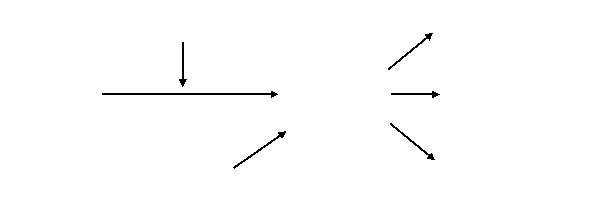
Figure 1: The conceptual framework approach to analyze the impact of WOM communication.
3.1 Research methodology
The theoretical framework for the research is based on media and communication, and marketing studies, this is an interpretative study using a quantitative method of data collection. The research project is distributed in two phases. The first phase is intended for data collection from secondary sources, with the purpose of adopting several communication and behavioral concepts that will eventually be tested. The second stage focus on quantitative data collection using a structured questionnaire with the purpose of study consumers’ attitudes towards user created products reviews on social mobile networks, this is where previously collected concepts from literature are tested. Each of these phases complement the next stages of the research by providing a concrete insight to explore findings and tests regarding the influence of Word of Mouth and the attitude of the consumers in WeChat in the purchase decision. The expected results represent the confirmations or rejections on the assumptions made in the development of this study after the understanding of the surveys made to consumers using the WeChat platform.
These are the hypothesizes raised in the beginning of this research:
H1: The purchasing decision processes of WeChat users are affected by the influence of the WOM.
* If the influence of WOM is related to the purchase decision of WeChat users, a significant correlation will be observed with an alpha of 0.05 between the influence of WOM and the purchase decision.
The null hypothesis will be the NO relationship between the influence of the WOM and the purchase decision of the users of WeChat.
H2: The purchasing decision processes of WeChat users are affected by the attitude of the consumers.
* If the consumer attitude is related to the purchase decision of the users of WeChat, a significant correlation will be observed with an alpha of 0.05 between the attitude and the purchase decision.
The null hypothesis will be the NO relation between the attitude of the consumers and the decision of purchase of the users of WeChat.
3.2 Sample characteristics
The population universe to which this study is directed is composed of all those users of WeChat, consumers of products and / or services. In order to test the proposed hypotheses, a non-probabilistic sampling has been developed in the opinion of the investigator, through the elaboration of a direct and structured questionnaire composed of 20 questions, carried out through a virtual platform and eventually spread through WeChat application.
The sample is composed of 100 individuals of both genders, participant selection filters were taken into account, that these people lived in china, who were users of WeChat and who were over 15 years.
3.3 Questionnaire design and measurement scales
A descriptive-correlational research was carried out, within a methodological framework of quantitative studies, using two scales of measurement: nominal and ordinal of discrete variation. For the preparation of the questionnaire, different types of questions were used to obtain the data to carry out the respective study: demographic questions; related to personal aspects (age, gender), dichotomous questions; with a single answer option (Yes / No), categorical questions; with multiple response options and qualification questions; Where the respondents select a single qualification for the proposed question.
Based on the literature and for the purposes of this study, the influence of WOM and the consumer’s attitude are considered independent and predictor variables, being determinants and having a fundamental role in the research. The purchase decision is considered a dependent and criterion variable. Additionally, the variables of age and gender have been selected as control variables.
For research purposes, after contemplating internal and external factors, an attempt will be made to understand the purchase decision through the consumer’s attitude and the influence of WOM, the attitude will be understood as: a learned and consistent predisposition to respond positively or negatively to the Presence of a product, brand or service. The purchase decision will be understood as: the choice to acquire a product or service after an evaluation of alternatives. Likewise, the influence of the WOM will be understood as the power of recommendation of a particular product or service prior to the evaluation and purchase decision.
Table 2: Measurement items based on supportive literature review
IV. Data Analysis
4.1 Summary of findings
Once the survey has been carried out, we proceed to analyze and interpret the data obtained through it, obtaining as a result the following information regarding the sample object of this study.
Graphic 1: “Preference of the source”
A large part of the sample, exactly 86%, believes more in the information they hear from nearby people than in the information presented in advertising pieces.
49% of the men replied Strongly Agree and 36% replied Agree, so we can understand that 85% of the male sample agrees with this point. The same happens in the case of women. The 39% are Strongly Agree and 48% Agree, so we can conclude that 87% of the female sample also believes more in what people say, than in what they see in advertising. (Appendix 2, graphic 1)
Graphic 2: “Preference of the source in age ranges”
If we analyze the responses based on the age variable, we can observe that the approval rate decreases as the participants are older. While in the range of 15 to 25 years 91% responded Strongly Agree or Agree, in the over 50 age range 75% responded Strongly Agree or Agree. (Appendix 3, table 1)
Graphic 3: “Trust on friends’ recommendations about everyday products”
According to the data obtained in the survey, 74% of the respondents rely on friends’ recommendations to buy everyday products.
23% of the men replied Strongly Agree and 46% replied Agree, so we can understand that 69% of the male sample agrees with this statement. Similarly, 26% of women are Strongly Agree and 51% Agree, so we can conclude that 77% of the female sample also relies more on their friends’ recommendations to buy everyday products. (Appendix 2, graphic 2)
Graphic 4: “Trust on friends’ recommendations in age ranges”
Based on the age variable, we can observe that the approval rate decreases as the participants are older. While in the range of 15 to 25 years old 74% responded Strongly Agree or Agree, in the over 50 age range only 25% responded Agree. (Appendix 3, table 2)
Graphic 5: “Attitude towards negative WOM”
According to the data obtained in the survey, 74% of respondents claimed to be reluctant to use products or services that are negatively judged by their family, friends or colleagues.
Among the total of respondents, 51% of the men replied Strongly Agree and 28% replied Agree, so we can understand that 79% of the male sample agrees with this statement. Likewise, 20% of women are Strongly Agree and 51% Agree, so we can conclude that 71% of the female sample is also reluctant to use the products or services that are negatively judged by their strong ties. (Appendix 2, graphic 3)
Graphic 6: “Attitude towards negative WOM in age ranges”
Based on the age variable, we can observe that the approval rate decreases as the participants are older. While in the range of 15 to 25 years old 72% responded Strongly Agree or Agree, in the over 50 age range 50% responded Agree and disagree rate is higher with a 25%. (Appendix 3, table 3)
Graphic 7: “Expression of a negative experience”
An extensive part of the sample, exactly 90%, is more likely to tell their family and friends about a negative experience they had using a product or service.
Among the total of respondents, 49% of the men replied Strongly Agree and 44% replied Agree, so we can understand that 93% of the male sample agrees with this statement. Likewise, 51% of women are Strongly Agree and 38% Agree, so we can conclude that 89% of the female sample is also likely to tell their family and friends about a negative experience they had using a product or service. (Appendix 2, graphic 4)

Graphic 8: “Expression of a negative experience in age ranges”
Based on the age variable, we can observe that the approval rate increases as the participants are older. While in the range of 15 to 25 years old 94% responded Strongly Agree or Agree, in the over 50 age range 100% responded Agree. (Appendix 3, table 4)
Graphic 9: “Share of positive commentary”
An extensive part of the sample, exactly 96%, is more likely to tell their family and friends about a positive experience they had using a product or service.
Among the total of respondents, 36% of the men replied Strongly Agree and 59% replied Agree, so we can understand that 95% of the male sample agrees with this statement. Likewise, 39% of women are Strongly Agree and 58% Agree, so we can conclude that 97% of the female sample is also likely to tell their family and friends about a positive experience they had using a product or service. (Appendix 2, graphic 5)
Graphic 10: “Share of positive commentary in age ranges”
Based on the age variable, we can observe that the approval rate increases as the participants are older. While in the range of 15 to 25 years old 97% responded Strongly Agree or Agree, in the over 50 age range 100% responded Strongly Agree or Agree. (Appendix 3, table 5)
Graphic 11: “WOM trustfulness for the purchase of products”
When asking the respondents when they trusted more in word of mouth communication, 54% responded when planning to buy technical products, 26% when buying everyday products, 11% fashion products and 9% entertainment products.
Among the total of respondents, 54% of the male sample rely on word of Mouth when planning to buy technical products and 13% when entertainment products. while, 54% of the female sample also rely on Word of Mouth when planning to buy technical products, but 15% rely when planning to buy fashion products. (Appendix 2, graphic 6)
Graphic 12: “WOM trustfulness for the purchase of products in age ranges”
If we analyze the age variable, we can observe that the rate for technical products stays relatively stable between age ranges. for everyday products and fashion products, there is a noticeable difference between the age ranges, while in the range of 15 to 25 years, the rate for everyday products and fashion products is 6% and 19% respectively, when in the over 50 age range these components are higher, 25% for everyday products and 25% for fashion products. (Appendix 3, table 6)
Graphic 13: “Value of opinion”
The respondents seem to value more the opinion of friends (63%), followed by family with 33% when they are making a purchase decision of a product or service.
If we analyze the gender variable, we can observe there is not a noteworthy difference, 67% of the male sample value the opinion of friends and 31% the opinion of family when making a purchase decision of a product or service. 61% of the female sample value the opinion of friends and 34% the opinion of family. (Appendix 2, graphic 7)
Graphic 14: “Value of opinion in age ranges”
If we analyze the responses based on the age variable, we observe respondents in the age between 15 and 25 years consider more valuable the opinion of their friends, which corresponds to 69%, while it is only 25% in the over 50 age range. Also, with a 75 %, the opinion of the family is more valued in the over 50 age range, in the range of 15 to 25 years is only 25%. (Appendix 3, table 7)
Graphic 15: “Determinants on purchase decision”
This question showed that 76% of the respondents consider that Word of Mouth influences their purchasing decisions more, followed by leaders or influencers with 15%; finally, 9% responded that it was advertising.
When separating the results by gender, the same hierarchy continues to exist as when they were integrated, we observed it when 82% men and 72% women answered that Word of Mouth is the first determinant to influence their purchasing decisions. It also occurs when 13% of the male sample and 16% of the female average are attributed to the Leaders / influencers. Contrary to them, only a small difference is evident, the influence in advertising is more in women with 12%, than in men with 5%. (Appendix 2, graphic 8)
Graphic 16: “Determinants on purchase decision in age ranges”
Word of Mouth, with a 78% in the 15-25 age range and 75% in the over 50 age range, is the primary determinant of influencing their purchasing decisions. Even so, respondents in the over 50 age range do not consider leaders and opinion influencers, whereas it was the response of 22% in the15-25 age range. (Appendix 3, table 8)
Graphic 17: “The effect of negative commentary”
When asked if they would try a product or service if they have read a negative comment on WeChat about this, 69% responded that they would not try it, 31% said yes.
Men and women seem to have the same opinion about trying a product or service that has been rated negatively, 64% of the male sample and 72% of the female sample responded that they would not try it, while 36% of the sample Male and 28% of the female sample answered yes. (Appendix 2, graphic 9)
Graphic 18: “The effect of negative commentary in age ranges”
Now, if we analyze the sample from the age ranges, we find that the age range of 15 to 25 years is more inclined to not try the product or service, with 75%, 25% think they would try it, while in the over 50 age range, opinions are more divided, 50% say they would try the product or service, and the other 50% would not. (Appendix 3, table 9)
Graphic 19: “Attitude towards a bad experience”
In this occasion, we can observe that 31% of the sample surveyed rarely reports to others in WeChat if they had a bad experience. In addition, 40% only do so at times.
If we study the responses according to the gender of the participants, the responses do not vary much, but it can be shown that women tend to report more about a bad experience using a product or service. (Appendix 2, graphic 10)
Graphic 20: “Attitude towards a bad experience in age ranges”
If we now address age-based responses, we can see that younger participants (ages 15 to 25) rarely report poor WeChat experience (44%). On the other hand, only 22% of respondents between 36 and 50 years old and 25% of participants over 50 responded ‘Rarely’. (Appendix 3, table 10)
Graphic 21: “Opinion trustfulness for daily use items”
It can be seen that 51% (more than half of the sample) answered ‘Sometimes’, 31% ‘Most of the time’ and 7% ‘Always’. This means that people tend to rely on the opinions of others, when it comes to articles of daily use, articles that usually are not very expensive.
If we analyze the answers according to the gender of the participants, the results are maintained. In both scenarios, ‘Rarely’ appears below ‘Sometimes’ and ‘Most of the Time’. (Appendix 2, graphic 11)
Graphic 22: “Opinion trustfulness for daily use items in age ranges”
If we compare the responses in terms of age, we can see that people in the over 50 age range tend not to trust the opinions of others in WeChat when buying everyday products. Half of the sample responded ‘Rarely’ and the other half answered ‘Sometimes’. The Always and Most of the Time options did not appear as answers. (Appendix 3, table 11)
Graphic 23: “Opinion trustfulness for expensive items”
In the case of purchases of expensive items, the opinions of others in WeChat lose some relevance. ‘Sometimes’ and ‘Rarely’ answers appear in the first places with 43% and 26% respectively.
If we study the responses according to the participants’ gender, we can see that the ‘Most of the times’ option is greater for women (23%) than for men (13%), while That the ‘Sometimes’ option is higher in the case of men (49%) than in the case of women (39%). This makes us understand that when it comes to buying expensive items, women rely more on the opinions of others in WeChat. (Appendix 2, graphic 12)
Graphic 24: “Opinion trustfulness for expensive items in age ranges”
If we address the responses in relation to age, we can evidence that the older the participants, the less they believe in the opinions of others in WeChat when it comes to buying an expensive item. While in the 15 to 25 age range 19% always rely on opinions, in the range of 26 to 35 (the group with the closest age range) only 10% always trust. In the 36-50 and over 50 ranges, none of the participants selected the ‘Always’ option. (Appendix 3, table 12)
Graphic 25: “Attitude concerning a shameful product/service”
We can see that 69% of the sample would not share an experience related to a product or service they feel embarrassed to use.
If we study this question from the gender of the participants, we can see that men are more reluctant to communicate an experience they have had with products or services if they are embarrassed to use them. But women also follow this trend, as 66% of the sample of women answered No. (Appendix 2, graphic 13)
Graphic 26: Attitude concerning a shameful product/service in age ranges
Related to the age variable, we can say that the younger the participants, the less likely they are to share product or service experiences if they are embarrassed to use them. We can highlight this since in the range of 15 to 25 years, 91% answered No, whereas in the group of over 50, only 25% answered No. (Appendix 3, table 13)
Graphic 27: “Negative impression perception”
In general terms, 58% of the sample consider that sharing negative opinions about a product or service will NOT brand them as a negative person.
If we analyze the answers according to the gender of the participants, we can notice a slight variation between the answers of men and women. While only 38% of women believe that sharing negative opinions makes people seen as negative, 49% of men agree with this statement. (Appendix 2, graphic 14)
Graphic 28: “Negative impression perception in age ranges”
If we compare the answers in terms of age, we can see that although the answer is NOT always above YES, it is gaining ground as the age of participants increases. (Appendix 3, table 14)
Graphic 29: “Wellness in expressing negative experiences”
It can be seen that 55% of the sample do not believe that expressing negative experiences of a product in WeChat makes them feel better. But it should be noted that people who consider YES make up the remaining 45%.
If we study responses according to the gender of the participants, we can see that the majority of women (54%) say they feel better when they share a negative experience of a product, while the majority of men (69%) say NO. A significant difference according to the gender of the participants is then evident. (Appendix 2, graphic 15)
Graphic 30: “Wellness in expressing negative experiences in age ranges”
If we make a comparison in terms of age, we could say that age does not strongly condition the answers. In the range of 15 to 25 years, participants do not believe that expressing negative experiences of a product in WeChat makes them feel better (78%), the range from 26 to 35 responded YES with 55%, the range from 36 to 50 Answered that they do not with 56% and finally those over 50 in their entirety answered yes. (Appendix 3, table 15)
Graphic 31: “Trust on homophilous source”
On a general level, we can show that 92% would trust the opinion about a product of a person with whom they share interests.
With regard to the gender of participants, we can note that although men and women respond mostly YES, there is a difference between the two; Only 3% of women answered NO while 15% of men answered NO. (Appendix 2, graphic 16)
Graphic 32: “Trust on homophilous source in age ranges”
With respect to age, we can show that in most ranges the YES option obtains more than 90% of the answers, but curiously only in the range of 36 to 50 years this percentage decreases to 67%. We could say that in this age range, compared to the other three ranks, participants would rely less on the opinion about a product of a person with whom they share interests. (Appendix 3, table 16)
Graphic 33: “Motivations to share experiences”
Now, if the intention is to know why the participants share their opinions and experiences in WeChat, we can see that the answers are totally divided: 50% do it for Help or advise Others and 50% do it for their own self.
If we analyze the answers according to the gender of the participants, we can note a subtle difference between the reasons of men and the reasons of women. 54% of men do for their own self, while 52% of women do it for help / advise others. (Appendix 2, graphic 17)
Graphic 34: “Motivations to share experiences in age ranges”
If we compare the answers in terms of age, we could say that age does not condition the answers very much. In the 15-25 age range, participants share their opinions and experiences on WeChat because they mostly want to help / advise others (54%), in the range of 26 to 35 most answered for their own self (60%), In the range of 36 to 50 most answered to help / advise others (67%) and in the case of those over 50, the answers were divided equally (50% For Your Own and 50% Help / advise Others). (Appendix 3, table 17)
Graphic 35: “Sharing of comments with low degree of dissatisfaction”
Generally speaking, if the level of dissatisfaction is low, 66% of the participants would NOT share their dissatisfaction on WeChat and 34% would share it.
In relation to gender, women would tend to talk about their dissatisfaction more than men, a difference in the percentages of responses is evident: only 21% of men said YES while in women it was 43%. (Appendix 2, graphic 18)
Graphic 36: “Sharing of comments with low degree of dissatisfaction in age ranges”
Finally, if we make a comparison according to the ages of the participants, we can show that although the response with greater force is the same in all cases (NO), the percentages vary according to the age. In the range of 15 to 25 years the majority of participants would NOT share their dissatisfaction in WeChat (81%), in the range of 26 to 35 the percentage of NO decreases to 58%, the range from 36 to 50 decreases to 56% and in those older than 50 years the percentage of NO increases to 75%. (Appendix 3, table 18)
4.2 Correlation Analysis
Correlation #1: Influence of WOM vs purchase decision
In order to study the relationship between the independent variable ‘Influence of WOM’ and the dependent variable ‘Purchase Decision’, two questions were selected from the research instrument that refer to each variable:
I am reluctant to use the products or services that are negatively judged by my family, friends, or colleagues (influence of WOM).
Would you trust the opinions of others as posted on WeChat when buying daily use items? (purchase decision)
By making a relation between the influence of WOM and the purchase decision, a significance level of 0.02 is obtained, which determines that the results are statistically significant.
Table 3: Influence of WOM vs. purchase decision correlation
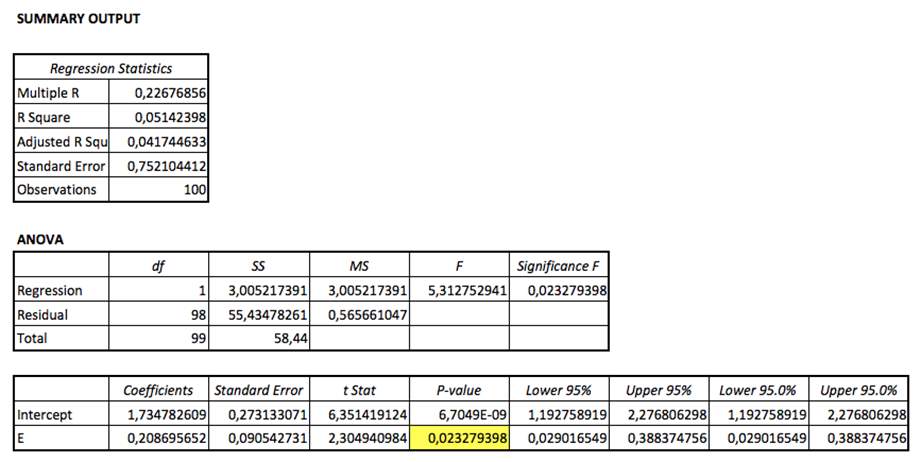
Correlation # 2: Consumer Attitude vs. Purchase Decision
In order to study the relationship between the independent variable ‘Attitude’ and the dependent variable ‘Purchase Decision’, two questions were selected from the research instrument that refer to each variable:
I believe the information I hear from people close to me more than I believe the ads (attitude).
I rely on my friends’ recommendations to buy everyday products on WeChat. (purchase decision).
By making a relation between the attitude and the purchase decision, a level of significance of 0.0001 is obtained, which determines that the results are evidently statistically significant.
Table 4: Consumer attitude vs. purchase decision correlation
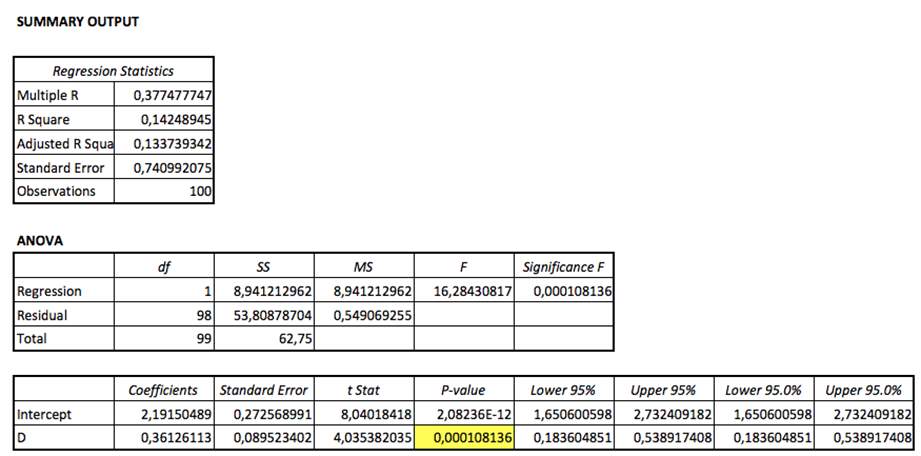
V. Discussion
The proximity between sender and a receiver is a determining factor for the WOM, given that the stronger the link between them, the greater the impact the message will have. In the study, it can be observed that this is indeed the case, regardless of factors such as Sex or age, 86% of the sample relies more on the information of people close to that in the one presented in advertising.
Negative perceptions can be an obstacle to online communications because they have a very large effect on the purchasing decision, since consumer perceptions are usually based on past personal experiences or reports of prior experiences from others, as shown by the data when in total 74% of respondents said they feel reluctant to use a product or service that has been negatively judged by others.
Strong ties are valuable for the transmission of information, but unfortunately these tend to express more negative WOM than the positive WOM. Evenly between genders and age, an extensive part of the sample, exactly 90%, is more likely to tell their family and friends about a negative experience they had using a product or service.
The greater the trust between the sender and the receiver, the greater the likelihood of getting involved in sharing the opinion, either by passing it on or receiving it. In this aspect, there seems to be a clear difference with respect to age, for respondents between 15 and 25 years seems more important the opinion of friends, but the greater the age of the sample, these seem to rely more on their family.
The dynamic qualities of the WOM allow the user to stop being an information receiver and become a co-creator, for this reason, WOM is the first determinant in the decision to buy with 76%, the generation of 15-25 years considers the influencers as a second option, which is not present in the sample of people over 50, where the Advertising takes second place.
It is more likely that a consumer will pay attention to negative information than to positive information, so negative information will have more power in the attitude and decision to purchase this. The results support this statement, when 69% of a sample has responded that they would not test a product or service if they knew of any bad comments about it. Even so it is interesting to observe how this trend changes in the older age range of the sample (over 50), when opinions are divided by 50/50.
People trust more on the opinions of others as posted on WeChat when buying daily use items than when buying expensive items, WOM still has its impact but when it comes to spending a large amount of money they do not reply on it.
Consumers hesitate on sharing their opinions about a product or service with others if they feel ashamed of it, we can prove it with our study, since 69% of the sample would not share an experience related to a product or service they feel Ashamed to use. What happens to be different with the age range over 50 years, when 75% of respondents said they will try it. Which makes us think that younger generations are more concerned about what people think of them.
Consciously, we assume people may avoid sharing negative information to avoid coming off as a negative person. In certain way, it is considered posting negative content can lead people to be liked less, but this not seen to be the case with the sample, regardless of factors such as Sex or age, 58% of the sample consider that sharing negative opinions about a product or service will not brand them as a negative person.
Considering that extremely dissatisfied customers are involved in greater WOM than consumers with high satisfaction, we observe different trends corresponding to gender variables, when the female sample responded that expressing in WeChat a negative experience with a product or service makes them feel better, While the male sample expressed the opposite.
It is implicitly assumed that similar people have similar needs and preferences, opinions in the sample are not the exception, 92% would rely on comments on a particular product or service from a person with whom they share the same interests.
People engage in functional conversations about a product, brand or service to obtain the information needed to eventually make decisions. Although the principal motives to share WOM are relatively self-centered and are explicitly motivated by the self and is even more evident in younger age groups such as the Y generation. On the contrary, the opinions seem to be notoriously divided in the sample and only 50% believe they share their opinions and experiences in WeChat for their own self.
When minor dissatisfaction is experienced, in most cases consumers do not complain or express negative comments about the product concerned. if the level of dissatisfaction is low, 66% of the participants would NOT share their dissatisfaction on WeChat. As for the gender variable, women would share it more than men.
VI. Conclusions
We reject the null hypothesis oriented to the non-relation of the influence of the WOM with the purchase decision in WeChat, since a high level of significance was evidenced. There is a significant correlation between this predictor variable of the influence of the WOM and the criterion variable of purchasing decision. WOM evidently plays an important role and is an influential factor in the purchase decision.
We reject the null hypothesis oriented to the non-relation of the attitude of the consumers with the purchase decision in WeChat. It was evidenced with a high level of significance that attitudes can determine a purchase decision. Motivations, barriers, trust, relationships and similarities are learned predispositions and draw particular attitudes that definitely affect a buying decision.
The motives for people to engage in sharing an opinion about a brand or product on WeChat are relatively self-centered and explicitly motivated by the self, this tendency is observed more in young age groups like generation Y. Given that these younger generations are more concerned about what others think, they will hesitate on sharing their opinions about a product or service with others if they feel ashamed of it. Individuals may avoid sharing negative information to avoid being categorized as a negative person, but this does not appear to be the case with the respondents, when regardless of factors such as Sex or age, the majority expressed that sharing negative opinions about a product or service will not brand them as a negative person. Negative comments can affect the purchase decision of the recipient, but also these seem to be a motivator when it comes to generating WOM, considering that extremely dissatisfied customers are involved in greater WOM than consumers with high satisfaction, the motivation here is that expressing in WeChat a negative experience with a product or service makes them feel better, this trend was observed more in women than men.
The proximity between sender and a receiver is a determining factor in influencing consumer attitudes towards WOM in WeChat, regardless of factors such as Sex or age, the majority of the respondents assured to trust more on the information coming from strong ties rather than the one presented in advertising. People trust more on the opinions of others as posted on WeChat when buying daily use items than when buying expensive items. Strong ties are valuable for the transmission of information, but can greatly affect the consumer’s attitude, since these tend to express more negative WOM rather than the positive WOM. Evenly between genders and age, an extensive part of the respondents stated they will tell their family and friends about a negative experience they had using a product or service.
It is implicitly assumed that similar people have similar needs and preferences, this is why we consider that the similarity between the sender and the receiver will eventually influence the attitude of the consumer towards WOM on WeChat, these individuals similar to the consumer, generate highly reliable and attractive information, that will finally have special power in their purchase decision. This concept is evidenced in the study when the opinions are supported in the literature, the majority of the respondents relies on comments coming from a person with whom they share the same interests.
The trust between the sender and the receiver, may impact on the likelihood of getting involved in sharing the opinion, either by passing it on or receiving it, what would eventually influence the attitude of the consumer towards WOM on WeChat. In this aspect, there seems to be a clear difference with respect to age, for respondents between 15 and 25 years seems more important the opinion of friends, but the greater the age of the sample, these seem to rely more on their family. This can be explained because, as we grow older, our circles of friendships are smaller and our priorities revolve around the family.
6.1 Theoretical and managerial implications
The eWOM is undoubtedly an effective tool that can have an extensive potential, this is something that companies should take advantage of, as their company is being commented, shared or conversed by clients who access services with other people, it is a way to position the image of your brand, given that if an acquaintance recommends it, it is more feasible that whoever receives the information is interested in accessing it. In addition, it is a way of doing marketing at no cost and makes these recommendations safer and more reliable.
By following the right strategies, e-WOM can also help increase sales, as it is one of the most effective and efficient mechanisms to fulfill this objective, since the recommendation is fundamental in the decision process before the purchase and alternatively allows companies to obtain a similar level of sales with a lower allocation of financial resources. Although WOM cannot be controlled by companies, they can create the environment or articulate mechanisms to foster the process of social interaction between people.
Likewise, e-WOM allows a better understanding of customer needs. Through e-WOM people express themselves freely and their opinions are recorded indefinitely on digital media. The availability of this information allows companies to analyze in detail what people think, their complaints and suggestions. Mechanisms that facilitate communication between companies and their clients reduce the likelihood of an angry client initiating a negative WOM. So, one aspect to be taken into account as the conclusion of this study is how to treat each client, as in the case depending on the age, young people care more about what others say, they surround themselves with more friends, when you grow older the group becomes smaller, time generates the maturity of making decisions, you consume something because you want it that way.
The eWOM can also have functions of a market research tool, many companies, especially those of great consumption, usually spend a lot of money in testing new products. These contributions that users often make can provide good ideas for the development of new products if they are subsequently organized and analyzed.
6.2 Limitations and Future Research
The size of the sample used, limits the degree to which the results can be generated, so the sample is not representative of the population under study. These aspects may pose some limitations for the correct results. Regarding future research, it would be interesting to perform the same using a more representative sample of the population under study.
The development of this study is mainly based on the analysis of the influence of word of mouth and the attitude of the consumers in WeChat in the purchase decision, A possible line of future research would be to deepen this analysis based on diverse ranges of consumer categorization, for example, based on their information searching practices, between the extreme polarities of info-active and info-passive Internet users.
This research serves as a guide for future studies related to the analysis of the attitude and behavior of the consumer, as well as the WOM and its influence on social mobile platforms such as WeChat.
Appendices
Appendix 1: Questionnaire
- What is your gender?
- Female
- Male
- What is your age?
- 15—25
- 26—35
- 36—50
- 50—
- I believe the information I hear from people close to me more than I believe the ads.
- Strongly Agree
- Agree
- Neither Agree nor Disagree
- Disagree
- Strongly Disagree
- I rely on my friends’ recommendations posted on WeChat to buy everyday products.
- Strongly Agree
- Agree
- Neither Agree nor Disagree
- Disagree
- Strongly Disagree
- I am reluctant to use the products or services that are negatively judged by my family, friends, or colleagues.
- Strongly Agree
- Agree
- Neither Agree nor Disagree
- Disagree
- Strongly Disagree
- I am likely to tell my family and friends about a negative experience I had using a product or service.
- Strongly Agree
- Agree
- Neither Agree nor Disagree
- Disagree
- Strongly Disagree
- I am likely to tell my family and friends about a positive experience I had using a product or service.
- Strongly Agree
- Agree
- Neither Agree nor Disagree
- Disagree
- Strongly Disagree
- I rely on word of mouth communication the most when I am planning to buy:
- Technical Products
- Fashion Products
- Everyday Products
- Entertainment Products
- While making a purchase decision of a product or service on WeChat, I most value the opinion of:
- Family
- Friends
- Colleagues
- Other__________
- What affects your buying decision the most?
- Advertising
- Word of mouth
- Leaders/ Influencers opinions
- If you read negative commentary on WeChat about a product or service would you try or not?
- Yes
- No
- Would you inform others on WeChat if you had a bad experience using a product or service?
- Always
- Most of the time
- Sometime
- Rarely
- Would you trust the opinions of others as posted on WeChat when buying daily use items?
- Always
- Most of the time
- Sometimes
- Rarely
- Would you trust the opinions of others as posted on WeChat when buying expensive items?
- Always
- Most of the time
- Sometimes
- Rarely
- Would you share on WeChat your experience with a product or service if you feel ashamed of using it?
- Yes
- No
- Do you think sharing on WeChat negative opinions about a product or service would make you appear as a negative person?
- Yes
- No
- Does expressing on WeChat a negative experience with a product make you feel better?
- Yes
- No
- Would you trust in a product opinion of someone with whom you share interests?
- Yes
- No
- Why do you share on WeChat your opinions about your experiences with products or services?
- for your own Self
- to help/ advice others?
- Would you share on WeChat your dissatisfaction about a product or service if the degree of dissatisfaction is low?
- Yes
- No
Appendix 2: Graphics

Graphic 1: “Preference of the source in male and female sample”
Graphic 2: “Trust on friends’ recommendations in male and female sample”

Graphic 3: “Attitude towards negative WOM in male and female sample”

Graphic 4: “Expression of a negative experience in male and female sample”

Graphic 5: “Share of positive commentary in male and female sample”
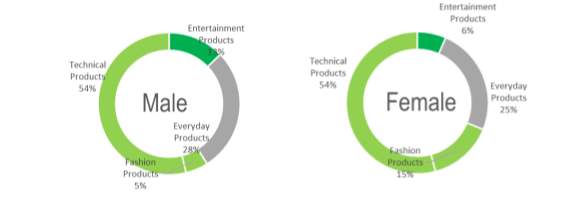
Graphic 6: “WOM trustfulness for the purchase of products in male and female sample”

Graphic 7: “Value of opinion in male and female sample”

Graphic 8: “Determinants on purchase decision in male and female sample”

Graphic 8: “The effect of negative commentary in male and female sample”

Graphic 9: “Attitude towards a bad experience in male and female sample”

Graphic 10: “Opinion trustfulness for daily use items in male and female sample”

Graphic 11: “Opinion trustfulness for expensive items in male and female sample”
Graphic 12: “Attitude concerning a shameful product/service in male and female sample”

Graphic 13: “Negative impression perception in male and female sample”

Graphic 14: “Wellness in expressing negative experience in male and female sample”

Graphic 15: “Trust of homophilous source in male and female sample

Graphic 16: “Motivations to share experiences in male and female sample”

Graphic 17: “Sharing of comments with low degree of dissatisfaction in male and female sample”
Appendix 3: Tables

Table 1: Preference of the source in age ranges

Table 2: Trust on friends’ recommendations in age ranges
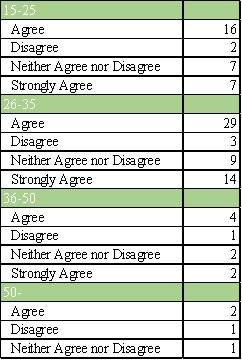
Table 3: Attitude towards negative WOM in age ranges
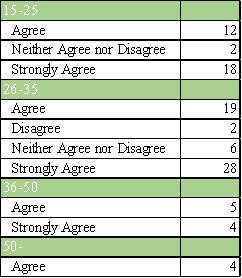
Table 4: Expression of a negative experience in age ranges
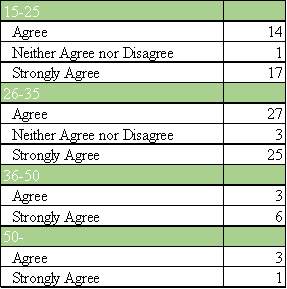
Table 5: Share of positive commentary in age ranges
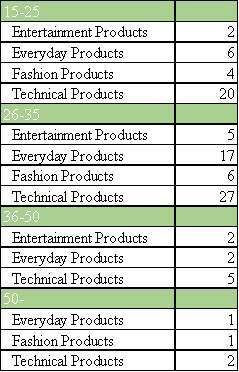
Table 6: WOM trustfulness for the purchase of products in age ranges
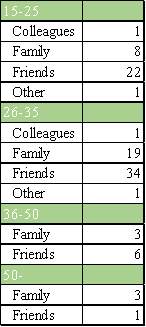
Table 7: Value of opinions in age ranges
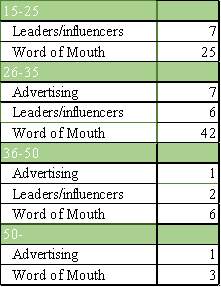
Table 8: Determinants on purchase decision in age ranges
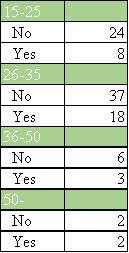
Table 9: The effect of negative commentary in age ranges
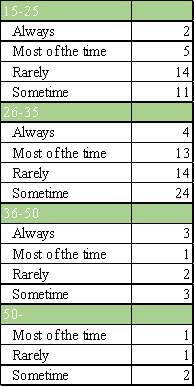
Table 10: Attitude towards a bad experience in age ranges
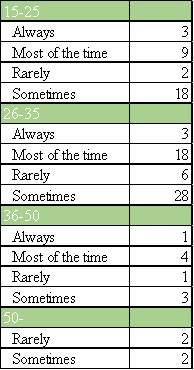
Table 11: Opinion trustfulness for daily use items in age ranges
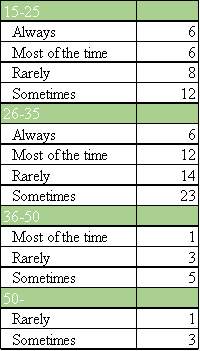
Table 12: Opinion trustfulness for expensive items in age ranges
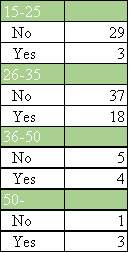
Table 13: Attitude concerning a shameful product/service in age ranges
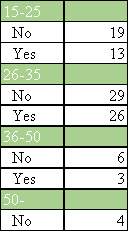
Table 14: Negative impression perception in age ranges
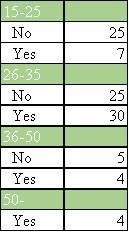
Table 15: Wellness in expressing negative experience in age ranges

Table 16: Trust on homophilous source in age ranges

Table 17: Motivations to share experiences in age ranges
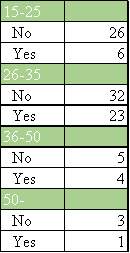
Table 18: Sharing of comments with low degree of dissatisfaction in age ranges
[1] Misner, I. R. The world’s best known marketing secret: Building your business with word-of-mouth marketing. 2nd ed. (Austin, TX: Bard Press, 1999).
[2] The Word of Mouth Marketing Association (WOMMA). LANDMARK STUDY Return of Word of Mouth (WOMMA, 2014).
[3] Jacques Bughin, Jonathan Doogan, and Ole Jørgen Vetvik, “A new way to measure word-of-mouth marketing”, McKinsey& Company, April, 2010, http://www.mckinsey.com/business-functions/marketing-and-sales/our-insights/a-new-way-to-measure-word-of-mouth-marketing. (Accessed October 16, 2016).
[4] George M. Zinkhan, and Richard T. Watson. “Advertising trends: Innovation and the process of creative destruction.” Journal of Business Research 37.3 (1996): 163-171.
[5] Katz, E. & Lazarsfeld, P. F. Personal influence; the part played by people in the flow of mass communications. (Glencoe, Illinois: Free Press, 1955).
[6] Johan Arndt. “Role of Product-Related Conversations in the Diffusion of a New Product.” Journal of Marketing Research 4, no. 3 (1967): 291-95. doi:10.2307/3149462.
[7] Westbrook. Product/Consumption-based Affective Responses and Post Purchase Processes, Journal of Marketing Research. (1987) 24, 258-270.
[8] Ivan R. Misner. The world’s best known marketing secret: Building your business with word-of-mouth marketing. 2nd ed. (Austin, TX: Bard Press, 1999).
[9] Lee, J., Park, D.-H. & Han, I. The effect of negative online consumer reviews on product attitude: An information processing view. Electronic Commerce Research and Applications. (2008) 7(3), 341.
[10] Barbara Gligorijevic, Consumer created reviews and ratings: The importance of word of mouth in information search. (2013).
[11] The Word of Mouth Marketing Association (WOMMA). LANDMARK STUDY Return of Word of Mouth (WOMMA, 2014).
[12] Misner. The world’s best known marketing secret: Building your business with word-of-mouth marketing. (1994).
[13] Katz, E. & Lazarsfeld. Personal influence; the part played by people in the flow of mass communications. (1966)
[14] Jonah Berger. Word of mouth and interpersonal communication: A review and directions for future research. (Philadelphia, Elsevier Inc, 2014).
[15] Hennig-Thurau, Thorsten, and Gianfranco Walsh. “Electronic Word-of-Mouth: Motives for and Consequences of Reading Customer Articulations on the Internet.” International Journal of Electronic Commerce 8, no. 2 (2003): 51-74. http://www.jstor.org/stable/27751096.
[16] Berger. Word of mouth and interpersonal communication: A review and directions for future research. (2014).
[17] Hennig-Thurau, Thorsten, and Walsh. Electronic Word-of-Mouth: Motives for and Consequences of Reading Customer Articulations on the Internet. (2003).
[18] WOMMA. LANDMARK STUDY Return of Word of Mouth (2014).
[19] Michael Trusov, Randolph E. Bucklin, and Koen Pauwels. “Effects of word-of-mouth versus traditional marketing: findings from an internet social networking site.” Journal of marketing 73.5 (2009): 90-102.
[20] Jonah Berger. Word of mouth and interpersonal communication: A review and directions for future research. (2014).
[21] Jo Brown, Amanda J. Broderick, and Nick Lee. “Word of mouth communication within online communities: Conceptualizing the online social network.” Journal of interactive marketing 21.3 (2007): 2-20.
[22] Safdar Hussain, Wasim Ahmed, Rana Muhammad Sohail Jafar, Haseeb Akhtar, Ambar Rabnawaz, Yang Jianzhou “Electronic word of mouth communications and consumer’s information adoption on the Internet.” Computer Communication and the Internet (ICCCI), 2016 IEEE International Conference on. IEEE, 2016.
[23] Barbara Gligorijevic, Consumer created reviews and ratings: The importance of word of mouth in information search. (2013).
[24] Shasha Tenga, Kok Wei Khongb, Alain Yee Loong Chongc, and Binshan Lind. “Persuasive Electronic Word-of-Mouth Messages in Social Media.” Journal of Computer Information Systems 57.1 (2017): 76-88.
[25] Christy MK. Cheung and Dimple R. Thadani. “The effectiveness of electronic word-of-mouth communication: A literature analysis.” Proceedings of the 23rd Bled eConference eTrust: implications for the individual, enterprises and society (2010): 329-345.
[26] Shasha Tenga, Kok Wei Khongb, Alain Yee Loong Chongc, and Binshan Lind. “Persuasive Electronic Word-of-Mouth Messages in Social Media”.
[27] Burhanuddin Shaikh. “Understanding Word of Mouth Communication: A Theoretical Review of Literature.” The International Journal of Business & Management 2.4 (2014): 58.
[28] Anne Martensen and Lars Grønholdt. “The role of social ties in word-of-mouth effectiveness: a segmentation approach.” Innovative Marketing 11.1 (2015): 7-16.
[29] Burhanuddin Shaikh. “Understanding Word of Mouth Communication: A Theoretical Review of Literature.
[30] Jo Brown, Amanda J. Broderick, and Nick Lee. “Word of mouth communication within online communities: Conceptualizing the online social network.” Journal of interactive marketing 21.3 (2007): 2-20.
[31] Shu-Chuan Chu and Kim Yoojung. “Determinants of consumer engagement in electronic word-of-mouth (eWOM) in social networking sites.” International journal of Advertising 30.1 (2011): 47-75.
[32] Barbara Gligorijevic, Consumer created reviews and ratings: The importance of word of mouth in information search. (2013).
[33] Erin M. Steffes and Lawrence E. Burgee. “Social ties and online word of mouth.” Internet research 19.1 (2009): 42-59.
[34] Shu-Chuan Chu and Kim Yoojung. “Determinants of consumer engagement in electronic word-of-mouth (eWOM) in social networking sites.” International journal of Advertising 30.1 (2011)
[35] Senthilkumar.S. Impact of Facebook Driven Word of Mouth Communication on the Online Buying Behavior. (2015)
[36] S Ramesh Kumar, U Dinesh Kumar, Anuradha Sridharan and Lakshmi Narasimham. “An Empirical Study on Tendencies towards word-of-mouth communication of mobile phone users.” (2010)
[37] Barbara Gligorijevic, Consumer created reviews and ratings: The importance of word of mouth in information search. (2013).
[38] Dale F. Duhan, Scott D. Johnson and James Wilcox. “Influences on consumer use of word-of-mouth recommendation sources.” Journal of the Academy of Marketing Science 25.4 (1997): 283.
[39] David Dubois, Andrea Bonezzi, and Matteo De Angelis. “Sharing with Friends Versus Strangers: How Interpersonal Closeness Influences Word-of-Mouth Valence.” Journal of Marketing Research 53.5 (2016): 712-727.
[40] Burhanuddin Shaikh. “Understanding Word of Mouth Communication: A Theoretical Review of Literature.
[41] Shu-Chuan Chu and Kim Yoojung. “Determinants of consumer engagement in electronic word-of-mouth (eWOM) in social networking sites.” International journal of Advertising 30.1 (2011)
[42] Guillermo Armelini and Julian Villanueva. “Electronic word of mouth: what do we know about this powerful marketing tool.” IESE Insight Review (2006).
[43] Jo Brown, Amanda J. Broderick, and Nick Lee. “Word of mouth communication within online communities: Conceptualizing the online social network.” Journal of interactive marketing 21.3 (2007): 2-20.
[44] Burhanuddin Shaikh. “Understanding Word of Mouth Communication: A Theoretical Review of Literature. (2014).
[45] Jo Brown, Amanda J. Broderick, and Nick Lee. “Word of mouth communication within online communities: Conceptualizing the online social network.” (2007).
[46] Guillermo Armelini and Julian Villanueva. “Electronic word of mouth: what do we know about this powerful marketing tool.” (2006).
[47] Barbara Gligorijevic, Consumer created reviews and ratings: The importance of word of mouth in information search. (2013).
[48] Christy MK. Cheung and Dimple R. Thadani. “The effectiveness of electronic word-of-mouth communication: A literature analysis. (2010).
[49] Guillermo Armelini and Julian Villanueva. “Electronic word of mouth: what do we know about this powerful marketing tool.” (2006).
[50] Shu-Chuan Chu and Kim Yoojung. “Determinants of consumer engagement in electronic word-of-mouth (eWOM) in social networking sites.” (2011)
[51] Jo Brown, Amanda J. Broderick, and Nick Lee. “Word of mouth communication within online communities: Conceptualizing the online social network.” (2007).
[52] Senthilkumar.S. Impact of Facebook Driven Word of Mouth Communication on the Online Buying Behavior. (2015).
[53] Yu-Hui Fang and Chia-Ying Li. “Electronic word-of-mouth on social networking sites: Cue validity and cue utilization perspectives.” Human Systems Management 35.1 (2016): 35-50.
[54] Shasha Tenga, Kok Wei Khongb, Alain Yee Loong Chongc, and Binshan Lind. “Persuasive Electronic Word-of-Mouth Messages in Social Media.” Journal of Computer Information Systems 57.1 (2017): 76-88.
[55] Yu-Hui Fang and Chia-Ying Li. “Electronic word-of-mouth on social networking sites: Cue validity and cue utilization perspectives.” (2016).
[56] Jonah Berger. “Word-Of-Mouth and Interpersonal Communication.” NA-Advances in Consumer Research Volume 41 (2013).
[57] Hennig-Thurau, Thorsten, and Walsh. “Electronic Word-of-Mouth: Motives for and Consequences of Reading Customer Articulations on the Internet.” (2003).
[58] Jonah Berger. “Word-Of-Mouth and Interpersonal Communication.” NA-Advances in Consumer Research Volume 41 (2013).
[59] Hennig-Thurau, Thorsten, and Walsh. “Electronic Word-of-Mouth: Motives for and Consequences of Reading Customer Articulations on the Internet.” (2003).
[60] Jonah Berger. “Word-Of-Mouth and Interpersonal Communication.” NA-Advances in Consumer Research Volume 41 (2013).
[61] Hennig-Thurau, Thorsten, and Walsh. “Electronic Word-of-Mouth: Motives for and Consequences of Reading Customer Articulations on the Internet.” (2003).
[62] Senthilkumar.S. Impact of Facebook Driven Word of Mouth Communication on the Online Buying Behavior. (2015).
[63] Barbara Gligorijevic, Consumer created reviews and ratings: The importance of word of mouth in information search. (2013).
[64] Jonah Berger. “Word-Of-Mouth and Interpersonal Communication.” NA-Advances in Consumer Research Volume 41 (2013).
[65] Jo Brown, Amanda J. Broderick, and Nick Lee. “Word of mouth communication within online communities: Conceptualizing the online social network.” (2007).
[66] Anne Martensen and Lars Grønholdt. “The role of social ties in word-of-mouth effectiveness: a segmentation approach.” Innovative Marketing 11.1 (2015): 7-16.
[67] Eugene W. Anderson. “Customer satisfaction and word of mouth.” Journal of service research 1.1 (1998): 5-17.
[68] Barbara Gligorijevic, Consumer created reviews and ratings: The importance of word of mouth in information search. (2013).
[69] Arnaud De Bruyn and Gary L. Lilien. “A multi-stage model of word-of-mouth influence through viral marketing.” International Journal of Research in Marketing 25.3 (2008): 151-163.
[70] Christy MK. Cheung and Dimple R. Thadani. “The effectiveness of electronic word-of-mouth communication: A literature analysis. (2010).
[71] Arnaud De Bruyn and Gary L. Lilien. “A multi-stage model of word-of-mouth influence through viral marketing.” International Journal of Research in Marketing 25.3 (2008).
[72] S Ramesh Kumar, U Dinesh Kumar, Anuradha Sridharan and Lakshmi Narasimham. “An Empirical Study on Tendencies towards word-of-mouth communication of mobile phone users.” (2010).
[73] Anne Martensen and Lars Grønholdt. “The role of social ties in word-of-mouth effectiveness: a segmentation approach.” Innovative Marketing 11.1 (2015).
[74] Ibid.
[75] S Ramesh Kumar, U Dinesh Kumar, Anuradha Sridharan and Lakshmi Narasimham. “An Empirical Study on Tendencies towards word-of-mouth communication of mobile phone users.” (2010).
[76] Helen Langan. “Research Shows Micro-Influencers Are Marketing’s Biggest Opportunity”, The Word of Mouth Marketing Association (WOMMA), April 28, 2016, https://womma.org/research-shows-micro-influencers-marketings-biggest-opportunity/ (accessed November 17, 2016).
[77] Marsha L. Richins. “Negative word-of-mouth by dissatisfied consumers: A pilot study.” The journal of marketing (1983): 68-78.
[78] Burhanuddin Shaikh. “Understanding Word of Mouth Communication: A Theoretical Review of Literature. (2014).
[79] Eugene W. Anderson, “Customer satisfaction and word of mouth,” Journal of service research, Volume 1, No. 1 (1998):5-17.
[80] Burhanuddin Shaikh. “Understanding Word of Mouth Communication: A Theoretical Review of Literature. (2014).
[81] Marsha L. Richins, “Negative word-of-mouth by dissatisfied consumers: A pilot study.” The journal of marketing (1983).
[82] Anne Martensen and Lars Grønholdt. “The role of social ties in word-of-mouth effectiveness: a segmentation approach.” Innovative Marketing (2015).
[83] Ahmad Nawaz, Jolita Vveinhardt, and Rizwan Raheem Ahmed. “Impact of Word of Mouth on Consumer Buying Decision.” (2014).
[84] Martin Oetting, Monika Niesytto, Jens Sievert y Florian Dost. Study of Word-of-Mouth. Inform 01 (Trnd, 2014).
[85] Christy MK. Cheung and Dimple R. Thadani. “The effectiveness of electronic word-of-mouth communication: A literature analysis.” Proceedings of the 23rd Bled eConference eTrust: implications for the individual, enterprises and society.
Cite This Work
To export a reference to this article please select a referencing stye below:
Related Services
View allRelated Content
All TagsContent relating to: "Consumer Decisions"
The consumer decision making process involves how consumers identify their needs and gather and process information prior to a purchase. Consumer decisions involve how the emotions and preferences of consumers can impact their buying decisions.
Related Articles
DMCA / Removal Request
If you are the original writer of this dissertation and no longer wish to have your work published on the UKDiss.com website then please:

